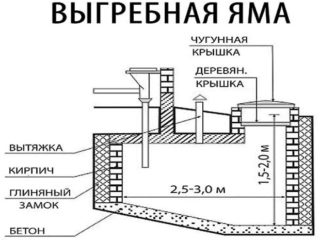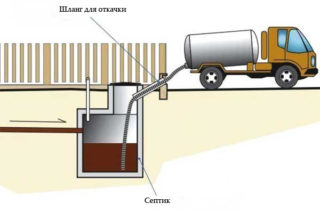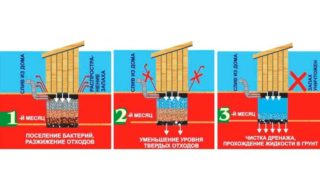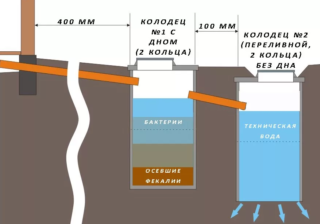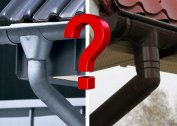A cesspool is an obligatory component of autonomous sewage for most owners of suburban areas. Therefore, the problem often arises of its rapid filling. Just a year after the start of operation of the system, the owner notices that the water does not leave the cesspool, even with regular pumping of effluents. You need to deal with the problem, otherwise the sewage system will completely fail.
The main causes of water retention in the cesspool
To understand why the receiver does not absorb water, you need to know its device. As a rule, a cesspool is a reservoir formed directly in the ground. In the best case, a drainage bottom is made of fine-grained gravel, river sand and broken brick. In the worst case scenario, they simply leave the bottom and walls unpaved. In both cases, it is assumed that the drains will be gradually absorbed (seeping) into the soil from the side of the walls and, to a greater extent, through the bottom. But over time, the absorption capacity of the earth / drainage bottom is seriously reduced. This happens for the following reasons:
- Siltation of the bottom - the formation of fecal sludge in the lower part of the pit. It forms a crust that keeps water out of the ground.
- The formation of fatty deposits on the walls and in the lower part of the pit. It also prevents water from entering the ground.
- Freezing soil in the winter. If the cesspool does not absorb water precisely at subzero temperatures, then this is about freezing the system.
- Inadequate receiver volume. Perhaps, more people have been using sewage systems recently, and additional household washing appliances have been connected. This leads to an early filling of the tank and the need for its frequent pumping.
According to sanitary standards, the formation of a simple pit in the area causes irreparable ecological damage to the environment. Such actions are criminally punishable. Therefore, it is desirable to have a pit with a sealed bottom, walls and an overflow chamber.
How to deal with poor outflow of water
You need to deal with the problem depending on its causes. In this case, the actions will be radically different.
Pit siltation
You will need a high-quality washing of the silty crust. To do this, you need to rent special equipment (sewer-ilosos). Sequencing:
- Primary pumping of drains from the receiver.
- Flushing sludge at the bottom under high water pressure.
- Parallel cleaning of the walls and bottom of the pit with brushes from accumulated dirt.
- Another flushing of the tank and pumping sludge.
In addition, you can use bacteria that will make the silty crust softer. But it is worth remembering that biological products work in a humid environment under the condition of plus temperatures.
When cleaning the pit, it is desirable to thoroughly rinse the entire collector to eliminate the formed sludge from its walls.
The formation of a greasy film on the walls and bottom of the pit
To be able to get rid of water in a cesspool in a natural way, you need to take care of the lack of fat in the drains. It is formed as a result of the ingestion of human waste, food waste into the sewer. In combination with cold water (at outdoor temperatures), fat gradually thickens, clogs the pores of the soil. From this, water ceases to go into the soil.
You can also deal with the problem by erosion plus the use of bacterial or chemical preparations.
The former actively corrode fecal silt and fat, decomposing them into organic matter (compost) and water.As a result, the volume of effluents is seriously reduced, and the need to often pump the pit disappears. But biologics reduce or completely neutralize their activity if there is an impurity in household sewage (powders, detergents, cleaners). Better use bacteria for the toilet pit. In this case, the temperature regime must be observed (bioadditives are warm) and the volume of water in the receiver. Well proven drugs "Vodograi", Microbec. They not only decompose fecal matter, but also process toilet paper, food peels.
Chemicals are based on nitrate oxidizing agents, formaldehyde or ammonium compounds. All drugs actively affect fat, fecal sludge, processing and destroying them. But there are a number of features that you need to know before using chemicals in a pit. The safest are nitrate oxidizing agents. The sludge formed after them can be used as compost. Ammonium-based chemicals work only at freezing temperatures.
Formaldehydes, although they kill odor, fecal sludge and fat, but completely destroy (“deaden”) the soil within a radius of 7-10 meters from the pit. On such soil, not even a weed will sprout. Drugs in this group are used extremely rarely.
Soil freezing
If it is found that the water from the sewer receiver does not leave well in the winter, it is important to ensure high-quality heating of the communication elements. And you need to start with the pipeline. It is well insulated, and for a greater effect, an electric cable is launched along the entire length of the tube.
In the pit itself, it is first desirable to warm the drains. To do this, you can pour a few tens of liters of hot water. Then take a metal rod, the height exceeding the depth of the receiver. They hammer it in the corner of the pit into the very soil through the silt. A bare wire is thrown onto the rod and plugged into the network with a plug. Here, frozen ground will work as an excellent current conductor. Melted soil will limit its movement further. Thus, the runoff will warm up in the pit along with the soil, and the water will freely leave.
It takes about a day to warm up a pit with a volume of 3-4 m3.
Small volume of sewer tank
If more people began to use the pit, its filling will be faster. In this case, you need to increase the useful volume of the receiver. To do this, it is enough to form another tank nearby and connect them with an overflow pipe. In parallel, the bottom of the first receiver can be concreted. In the second chamber, make a drainage bottom. The result is a complete septic tank, which does less harm to the environment. Drains in it are cleared by 68-70%.
Prevention of siltation of a sewer pit
To reduce the frequency of pumping of the sewer receiver, to prevent the formation of fat, sludge on its walls, it is important to take preventive measures.
- Timely pumping sewage from the pit. Especially if the sewage system is preserved for the winter.
- Regular flushing of the walls and bottom of the receiver under high pressure. This should be done at least once a year. Ideally, every six months.
- In the summer, it is advisable to use bacteria or chemicals that eliminate odor and prevent the formation of a greasy film in the pit.
- When installing a sewer receiver, it is important to consider the depth of soil freezing in the region. If necessary, the tank must be insulated.
Compliance with these simple measures allows us to ensure the reliable functioning of autonomous sewers for more than a dozen years.
